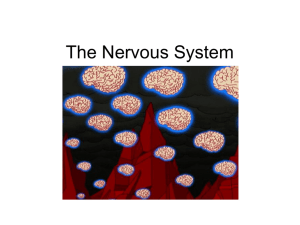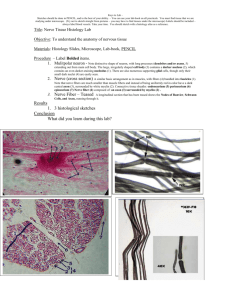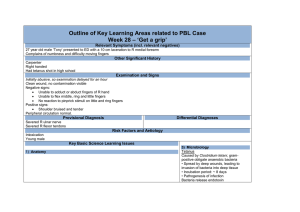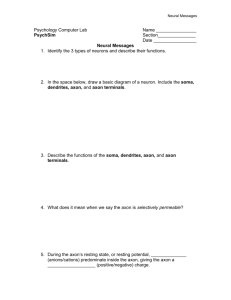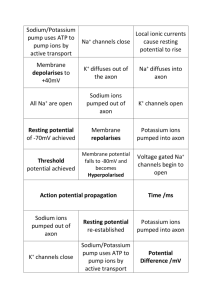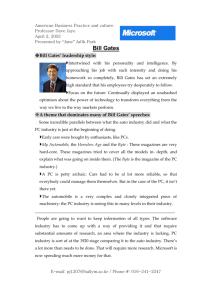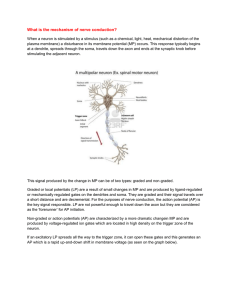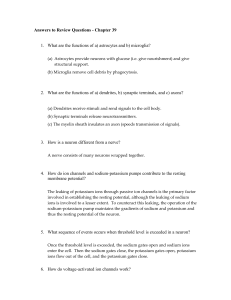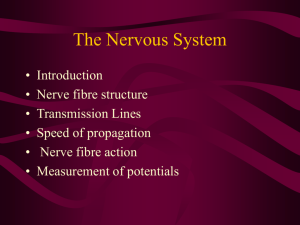Unit M Notes #2 - Nerve Impulse Generation - Mr. Lesiuk
advertisement
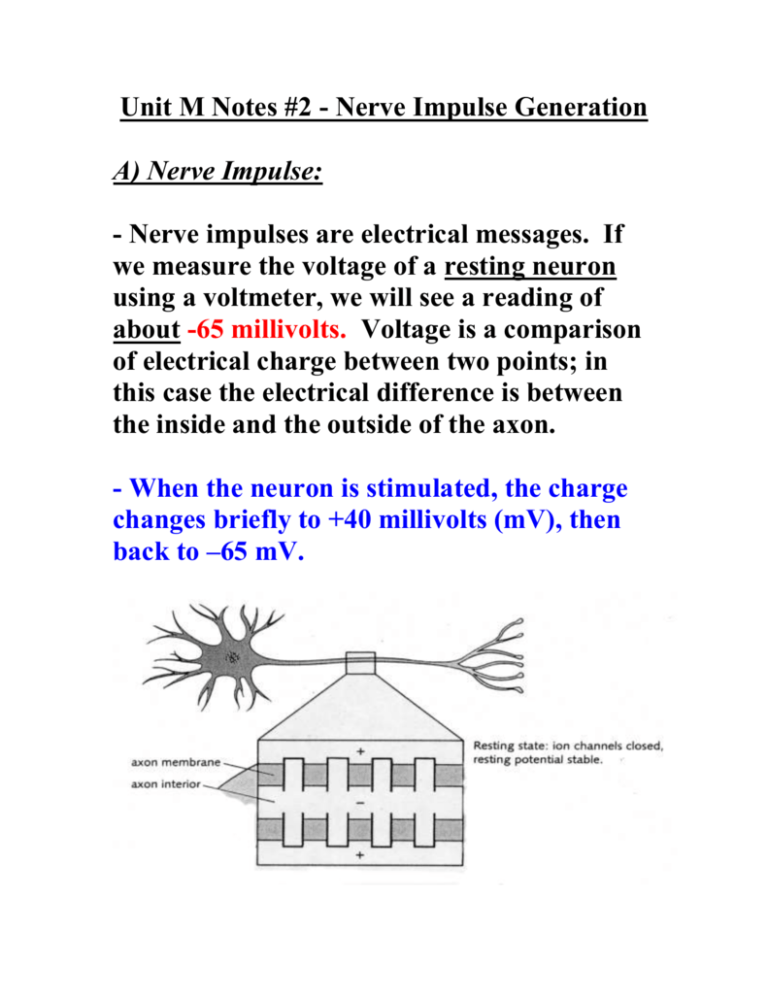
Unit M Notes #2 - Nerve Impulse Generation A) Nerve Impulse: - Nerve impulses are electrical messages. If we measure the voltage of a resting neuron using a voltmeter, we will see a reading of about -65 millivolts. Voltage is a comparison of electrical charge between two points; in this case the electrical difference is between the inside and the outside of the axon. - When the neuron is stimulated, the charge changes briefly to +40 millivolts (mV), then back to –65 mV. - If we hook up our voltmeter to a machine called an oscilloscope, we can see the change in voltage over a period of time. - The cause of this electrical difference is due to a difference in ion (charged atoms, - and +) distribution between the two sides of the membrane of the axon (axomembrane). B) Action Potential: Inside Axon At Rest : - 65 mV - Most Na+ ions are outside the axomembrane. - Most K+ ions are inside the axon (along with large negatively charged organic molecules). NEG NEG - The axomembrane is more permeable to K+ than to Na+, so more K+ ions leak across to the outside. This adds to the POSITIVE polarity to the outside of the axon. The NEGATIVE polarity to the inside is further emphasized because of the large negative protein molecules found inside the axon (axoplasm) cannot move out. *** -65 mV means that the inside is 65 mV more negative than outside*** Na+ Na+ K+ Na+ Na+ -K+ -K+ K+ --+ + Na -- K K+ Na+ Na+ Na+ Na+ Na+ - This situation is called Resting Potential. -65mV. To maintain this Resting Potential, both the (Na+) gates and the (K+) gates are closed, while the (Na+/K+) pumps are working hard. - When an axon or dendrite is stimulated, the sodium gates open which allows some Na+ to enter the Axoplasm (interior). Now, the inside becomes more positive than the outside by +40 mV. Na+ Na+ Na+ K+ -- K+ Na+ -K+ K+ --+ + -- K K Na+ Na+ K+ Na+ Na+ Na+ - This process is called the Upswing Phase of the Action Potential. The charge changes from –65 mV to +40 mV. The changed is called Depolarization. - After the sodium gates have opened, the potassium gates open, allowing K+ exit the axoplasm. K+ K+ Na+ K+ Na+ -- K+ Na+ -Na+ Na+ -- K+ -K+ -- Na+ K+ K+ Na+ K+ K+ Na+ K+ - This is called the Downswing Phase of the action potential. The charge returns to –65mv. This change is called Repolarization. **Note: Charge is back to normal, but the ions are reversed. (K+ are outside, while Na+ are inside). That is the opposite of the setup during resting potential. - Finally, there is a Recovery Phase in which the sodium/potassium pumps (through ACTIVE TRANSPORT) return Na+ to the outside and K+ to the inside. - So far we have only been looking at one point on the Axon or Dendrite. The opening of the sodium gates in one area causes the sodium gates in the next area to open. We get a wave-like motion (chain reaction) moving down the nerve fiber. Na+ ++ + + + + + +++ + - - - - - - - - - - K+ - - - - - - - - - - - - - + + + + + + +++ + + Na+ K+ +++ -- + + +++ + - - - ++- - - - - - Na+ - - - - - ++ - - - - - - - + + + - - + + + + + + + K+ SEE ANIMATIONS: http://www.youtube.com/watch?v=nrTDY-SzQ7E http://www.youtube.com/watch?v=dSkxlpNs3tU Summary of Action Potential 1. RESTING POTENTIAL -Charge is –65mV - Na+ outside - K+ inside 2. UPSWING OF ACTION POTENTIAL -Depolarization -Charge from –65mV back to +40mV - Na+ moves inside -(Sodium gates opened) 3. DOWNSWING OF ACTION POTENTIAL -Repolarization -Charge from +40mV back to –65mV - K+ moves outside -(Potassium gates opened) 4. RECOVERY PHASE -Charge is –65mV -Sodium/Potassium Pump -Moves Na+ out and K+ inside ****NOW NEURON CAN BE RESTIMULATED**** ****REMEMBER THIS IS A WAVE-LIKE MOTION DOWN THE NEURON**** C) Myelinated Vs. Unmyelinated Fibers Myelinated Neuron Schwann cells Node of Ranvier - When a nerve fiber is myelinated, it is covered by Schwann cells, this design allows the nerve impulse to skip from node to node. - In myelinated axons and dendrites, the impulse can travel up to 200m/sec. In unmyelinated fibers, the maximum speed is 20 m/sec. - This difference in speed is because the action potential is able to jump over the myelin sheath. Depolarization only occurs at each of the nodes of Ranvier. This jumping is referred to “Saltatory Conduction”. - Invertebrates lack a myelin sheath, therefore they do not exhibit this faster “saltatory conduction”. See Animation: http://www.youtube.com/watch?v=pnB_Hc-Qfs0
